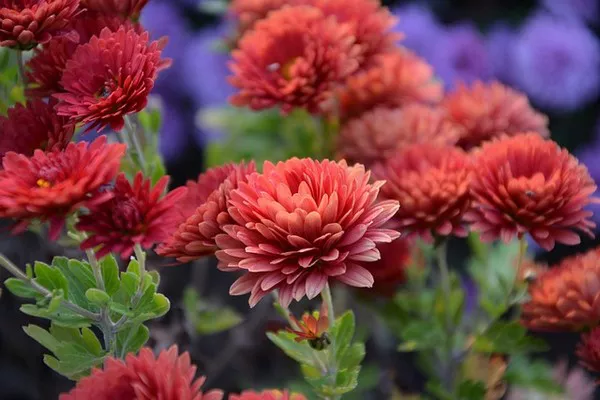In the vast realm of botanical wonders, the dahlia flower stands as a testament to nature’s creativity and elegance. Revered for its captivating beauty and diverse array of colors, shapes, and sizes, the dahlia is a horticultural gem that has captured the hearts of garden enthusiasts and florists alike. In this article, we embark on a journey to unravel the intricate details of what makes the dahlia a floral masterpiece, exploring its characteristics, varieties, and the cultural significance that has made it a perennial favorite.
The Anatomy of Dahlia: A Symphony of Petals and Form
At first glance, the dahlia presents itself as a breathtaking tapestry of petals, arranged in various patterns and configurations. The most distinctive feature of the dahlia is its composite flower head, composed of two types of florets: ray florets and disk florets. The ray florets are the outer petals that radiate from the center, creating the flower’s overall shape and providing a striking visual impact. Meanwhile, the disk florets form the central disc, resembling a tiny button nestled within the embrace of the ray florets.
The colors of the dahlia are a true spectacle, spanning a vast spectrum that includes rich reds, vibrant oranges, sunny yellows, calming blues, and delicate pinks. Additionally, some varieties exhibit captivating bicolor combinations, further enhancing the visual appeal. The hues are not confined to solid colors, as dahlia petals often showcase gradients, giving the impression of a living watercolor painting.
Varieties Galore: A Kaleidoscope of Shapes and Sizes
Dahlias are not a one-size-fits-all flower; in fact, they come in a myriad of sizes and shapes, each possessing its unique charm. From petite pompoms to dinner-plate-sized blooms, the diversity of dahlia varieties is truly astonishing. Let’s delve into some of the most popular types, showcasing the range of sizes and shapes that make these flowers so enchanting.
Pompom Dahlias: Characterized by their petite, spherical blooms, pompom dahlias resemble charming floral orbs. Their compact size and abundance of petals create a delightful and whimsical appearance, making them a favorite for bouquets and garden borders alike.
Cactus Dahlias: Named for their resemblance to cactus flowers, these dahlias boast spiky, tubular petals that give them a distinctive, dynamic appearance. The intricate structure of the petals adds an extra layer of fascination to these already captivating blooms.
Dinner-Plate Dahlias: As the name suggests, these dahlias boast enormous blooms, often reaching sizes of 10 inches or more in diameter. The sheer grandeur of their size makes them a showstopper in gardens and floral arrangements, commanding attention with their impressive presence.
Anemone Dahlias: Featuring a unique blend of ray florets and a central cluster of disk florets, anemone dahlias create a captivating contrast in texture and form. This variety adds a touch of complexity and sophistication to floral displays.
Waterlily Dahlias: Resembling the serene beauty of water lilies, these dahlias showcase layers of delicate, slightly curved petals, creating a bloom that exudes grace and tranquility. Their ethereal appearance makes them a popular choice for weddings and other special occasions.
Ball Dahlias: With their rounded, fully double blooms, ball dahlias strike a balance between the compactness of pompom dahlias and the opulence of dinner-plate dahlias. This versatility makes them a versatile choice for various floral arrangements.
Cultural Significance: Dahlias Across Time and Space
Beyond their visual allure, dahlias have etched their presence into the cultural tapestry of societies around the world. Originating from the high-altitude regions of Mexico, dahlias were initially cultivated by the Aztecs for both culinary and ornamental purposes. Spanish explorers later introduced these captivating blooms to Europe in the 18th century, sparking a horticultural revolution that continues to thrive today.
In Victorian England, dahlias became a symbol of luxury and elegance, adorning the gardens of the aristocracy. The flower’s popularity spread rapidly across the globe, reaching Asia, where it became associated with various cultural and religious celebrations. In some cultures, dahlias are even believed to symbolize the eternal bond of love and commitment.
In contemporary times, dahlias have become a staple in floral arrangements for weddings, special events, and everyday bouquets. Their versatility in terms of colors and shapes makes them a favorite among florists seeking to create visually stunning and personalized compositions. Furthermore, dahlias continue to be celebrated in horticultural exhibitions and competitions, where enthusiasts showcase their prized blooms and compete for prestigious awards.
Cultivating Dahlias: A Gardener’s Delight
For those who aspire to cultivate the captivating beauty of dahlias in their own gardens, understanding the basics of dahlia care is essential. These resilient flowers thrive in well-drained, fertile soil and prefer full sunlight to unleash their full potential. Proper spacing is crucial, allowing for adequate air circulation and preventing the onset of diseases.
Dahlias are typically grown from tubers, and the planting process involves placing these tubers in the ground after the last frost has passed. Regular watering, mulching, and occasional fertilization contribute to the health and vitality of the plants. As dahlias grow, diligent deadheading – the removal of spent blooms – encourages continuous flowering throughout the growing season.
To safeguard dahlias from pests and diseases, gardeners may employ organic methods or, if necessary, use targeted pesticides. Proper staking is also crucial for taller varieties, ensuring that the weight of the blooms does not cause the stems to bend or break.
Conclusion
In conclusion, the dahlia flower stands as a testament to the boundless beauty that nature can create. From its intricate anatomy to the diverse array of varieties and its rich cultural significance, the dahlia has earned its place as a beloved and timeless floral icon. Whether adorning gardens, events, or bouquets, dahlias continue to enchant and inspire, their vibrant colors and unique forms weaving a visual symphony that captivates the hearts of all who encounter them. As we celebrate the mesmerizing allure of dahlias, we are reminded of the power of nature to bring joy and beauty into our lives, one petal at a time.


